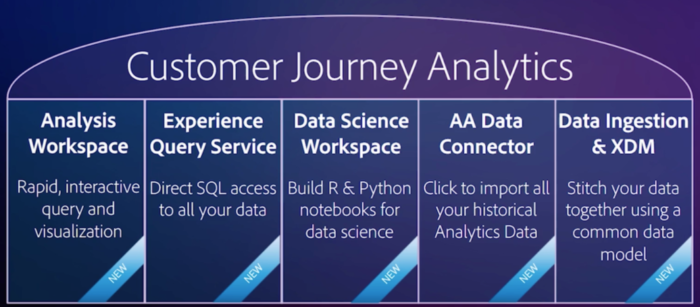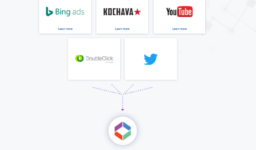Adobe Analytics has long been the undisputed leader in the world of Web Analytics and is still a marquee product for analyzing web and mobile app data. Just like any enterprise level product, it does come with its share of challenges.
So, is there a solution that can make these challenges go away?
YES there is and the solution to these challenges is Customer Journey Analytics. Customer Journey Analytics or CJA is an enterprise-wide analytics product that is built on Adobe Experience Platform. CJA allows us to join different data sources (online & offline) to give a complete view of our customers in real-time across channels. Please note that CJA is considered an add-on to Adobe Analytics, also available for Non-Platform (AEP) customers, and works natively with Adobe Experience Platform.
In this article, I’ll compare Adobe Analytics with CJA based on a set of standard capabilities that are common between the two solutions and highlight some of the differences.
Adobe Analytics
In this section, I’ve listed the various capabilities of Adobe Analytics and added a high level writeup explaining each of these separately. I’ve done the same for Customer Journey Analytics.
1. Data Capture
- Primarily takes place based on the AppMeasurement library (client-side-web), Mobile SDK (mobile app), Data insertion API and Bulk Data Insertion API (server-side).
2. Data Usage
- Data is stored in Report Suites usually setup to receive data globally or individually based on the requirement.
- Virtual Report Suites (VRS) can be created to “split” data based on web/mobile, region or Business group and can be setup based on custom session timeouts, expiration and time zones.
3. Reporting and Analysis
- Data is visualized in Analysis Workspace or the legacy UI.
- Workspace panel includes Freeform, Cohort, Fallout etc. options available to visualize data.
- Calculated metrics can be created, and marketing channels can be used for further analysis.
- Robust data export capabilities (PDF, CSV etc. formats) as well as access to raw data feeds.
- Ability to setup alerts in case of anomalies.
4. Identity
- Primarily based on cookies for client-side web tagging.
- Based on ECID for mobile app (tied to each installed instance of the app).
- Customer IDs converted to ECID for server-side implementations in general.
- Device graph data can be accessed via the People metric or leveraged via Cross-Device Analytics.
5. Segmentation
- Segmentation built into Analysis Workspace
- Visitor, Visit and Hit segment containers available.
- Sequential segmentation and exclusion capabilities available to users.
6. Data Limitations
- Limited to 200 eVars/props and 1000 events.
- UI limited to 500K unique rows of data per month (Low Traffic).
7. Data Classifications
- Classifications subject to the same restrictions as the UI in terms of only classifying the top 500K rows.
8. Historical Data Ingestion
- Historical data sent in but out of order hits can affect the sequence of events and attribution of eVars and marketing channels.
9. User Permissions
- User permissions are granted via the Admin Console at a more granular level for report suites etc. at a product profile level.
10. Data Latency
- Data can take up to 2 hours to be fully available in Adobe Analytics.
Customer Journey Analytics
Customer Journey Analytics (CJA) represents an upward paradigm shift. Clickstream data is no longer THE data source, it’s ONE OF MANY data sources. CJA makes it possible to link, define, process, join, visualize, and analyze any type of standardized data.

In this section, I’ve put CJA through the same set of capabilities as I did for Adobe Analytics. Please note that there are some features that CJA lacks compared to Adobe Analytics which the product team is working on to add support for.
1.Data Capture
- Data needs to be conformed to Adobe Experience Platform’s XDM schema to bring in any type of data.
- Web SDK is used for real-time data streaming and streaming API will be available for sending data server-side.
2.Data Usage
- Data is stored in datasets created within Adobe Experience Platform and added to CJA as Connections.
- Data Views are similar to VRS which also allow us to define data based on the type of datasets being analyzed as well as setting custom session timeouts, expiration and defining separate time zones.
3.Reporting and Analysis
- Data in CJA is visualized in Analysis Workspace.
- Workspace panel includes Freeform, Cohort, Fallout etc. options available to visualize data.
- Calculated metrics can be created for further analysis, but marketing channel support is not available yet, but support is planned.
- No current ability to export data in CJA (Workspace) but support is planned. However, Query Service and Data Access API provides the ability to export data.
- No current ability to setup alerts but support is planned.
4.Identity
- Tied directly to the Namespace defined within Adobe Experience Platform.
- Custom namespaces can be defined.
- ID can be based on anything be it cookies, CRM id, Loyalty ID or Phone number.
- Data in the device graph is NOT available yet but support is planned.
5.Segmentation
- Filters built into Analysis Workspace.
- Person, Session and Event segment containers available.
- Leverages the same standard segmentation UI/features as Adobe Analytics.
6.Data Limitations
- Unlimited number of rows and unique values.
- Unlimited metrics and dimensions and data in eVars/props is available in XDM format within CJA.
7.Data Classifications
- Lookup Datasets created in Platform are not subject to any volume restrictions in terms of volume but there is a 1 GB limit which isn’t “enforced”.
8.Historical Data Ingestion
- Any missing historical data can be uploaded into Adobe Experience Platform and then leveraged in CJA including support for out of order hits for a person.
9.User Permissions
- Permissions are assigned at the admin level to all users by default, but support is planned to add more granular access at the data view level.
10.Data Latency
- Data isn’t available in near real-time can be take up to 2 hours, but real-time support is being looked into.
Customer Journey Analytics (CJA) allows you to analyze your customer’s journey across channels using any data available to you in Adobe Experience Platform, leveraging the power of Analysis Workspace for rapid insights. Learn more at adobe.ly/aacja
| ID | Capability | Adobe Analytics | Customer Journey Analytics |
|---|---|---|---|
| 1 | Data Capture | Data is captured using the App Measurement library(client-side-web), Mobile SDK (mobile app), Data insertion API and Bulk Data Insertion API (server side) | • Data needs to be conformed to Adobe Experience Platform’s XDM schema to bring in any type of data. • Web SDK is used for real-time data streaming and streaming API will soon be available for server-side. |
| 2 | Data Usage | • Data is stored in Report Suites usually set up to receive data globally or individually based on the requirement. • Virtual Report Suites (VRS) can be created to “split” data based on web/mobile, region, or Business group and can be set up based on custom session timeouts and all timezones. | • Data is stored in datasets created within Adobe Experience Platform and added to CJA as Connections. • Data Views are similar to VRS which also allow us to define data based on the type of datasets being analyzed as well as setting custom session timeouts and defining separate time zones. |
| 3 | Reporting and Analysis | • Data is visualized in Analysis Workspace or the legacy UI. • Workspace panel includes Freeform, Cohort, Fallout etc. options available to visualize data. • Calculated metrics can be created, and marketing channels can be used for further analysis. • Robust data export capabilities (PDF, CSV etc. formats) as well as access to raw data feeds. • Ability to setup alerts in case of anomalies. | • Data in CJA is visualized in Analysis Workspace. • Workspace panel includes Freeform, Cohort, Fallout etc. options available to visualize data. • Calculated metrics can be created for further analysis, but marketing channel support is not available yet, but support is planned. • No current ability to export data in CJA (Workspace) but support is planned. However, Query Service and Data Access API provides the ability to export data. • No current ability to setup alerts but support is planned. |
| 4 | Identity | • Primarily based on cookies for client-side web tagging. • Based on ECID for mobile app (tied to each installed Platform. instance of the app). • Customer IDs converted to ECID for server-side number, implementations in general. • Device Graph data can be accessed via the People metric leveraged via Cross-Device Analytics | • Tied directly to the Namespace defined within Adobe Experience Platform • ID can be based on anything be it cookies, CRM id, Loyalty ID or Phone • Custom namespaces can be defined. • Data in the device graph is NOT available yet but support is planned. |
| 5 | Segmentation | • Built in Analysis Workspace • Hit, Visits and Visitor Containers available • Sequential segmentation and exclusion capabilities available to users. | • Filters built into Analysis Workspace • Person, Session and Event segment containers available • Leverages the same standard segmentation UI/features as Adobe available to users. |
| 6 | Data Limitations | • Limited to 200 eVars/props and 1000 events. • UI limited to 500K unique rows of data per month(Low Traffic) | • Unlimited metrics and dimensions and data in eVars/props is available in XDM format within CJA. • Unlimited number of rows and unique values. |
| 7 | Data Classifications | • Classifications subject to the same restrictions as the UI in terms of only classifying the top 500K rows. | • Lookup Datasets created in Platform are not subject to any restrictions in terms of volume. |
| 8 | Historical Data Ingestion | • Historical data sent in but out of order hits can affect the sequence of events and attribution of eVars and marketing channels. | • Any “missing” historical data can be uploaded in Adobe Experience Platform and then leveraged in CJA including support for out of order hits for a person. |
| 9 | User Permissions | • User permissions are granted via the Admin Console at a more granular level for report suites etc. at a product profile level. | • Permissions are assigned at the admin level to all users by default, but support is planned to add more granular access at the data view level. |
| 10 | Data Latency | • Data can take up to 2 hours to be fully available in Adobe Analytics. | • Data isn’t available in near real-time can be take up to 2 hours, but real time support is being looked into. |
Hope this article provided you with some more information and context to figure out some similarities and differences between Adobe Analytics and Customer Journey Analytics. The key points to consider would be to see if you analyze large amount of dimensional data (exceeding 500K unique rows per month), often analyze customer data across multiple channels, need to add missing historical “hit level” data after the fact or connect offline data with online with the aim to get a single view of the customer, then you should seriously consider CJA.
Check Customer Journey Analytics Feature Support



[…] Comparison Between Adobe Analytics and Customer Journey Analytics AdobeAdobe LaunchCJALaunchmarketing Share This Article […]
Customer journey analytics is merging together of each touchpoint in which consumer interacts through multiple channels. Rising trends of analytics attributed to the growth in availability of data in real-time and digitization leads into the acceptation for consumer behavior data analysts. The analysis primarily concentrates on market operations to take effective marketing decisions.